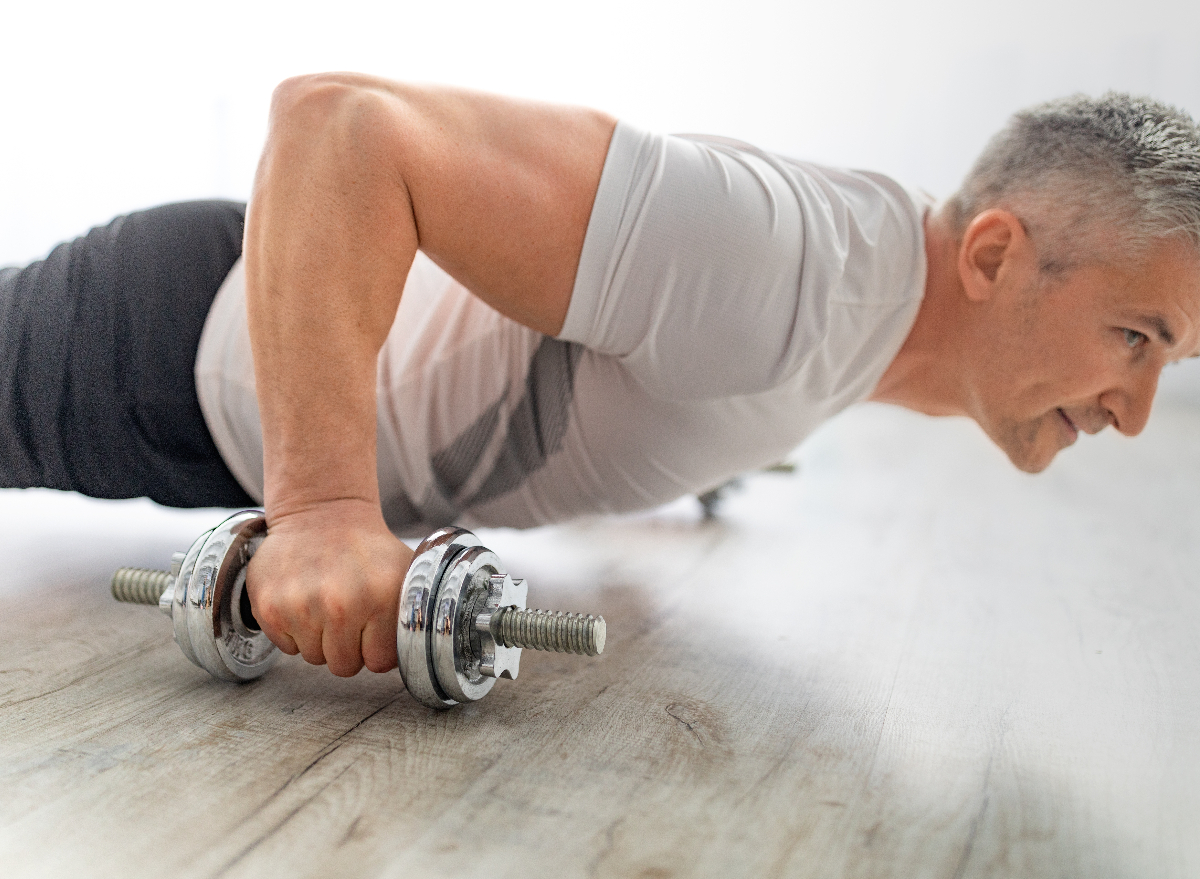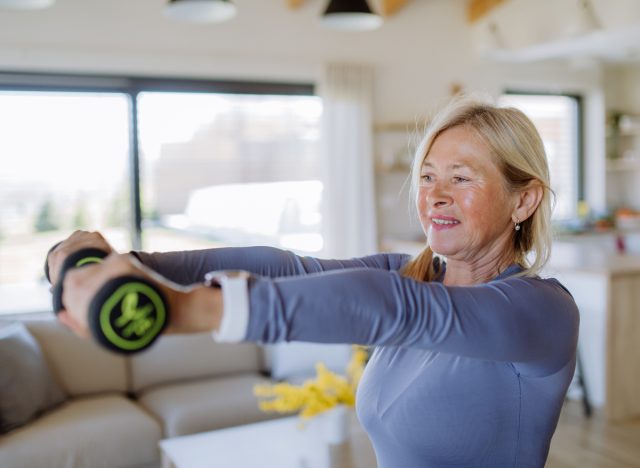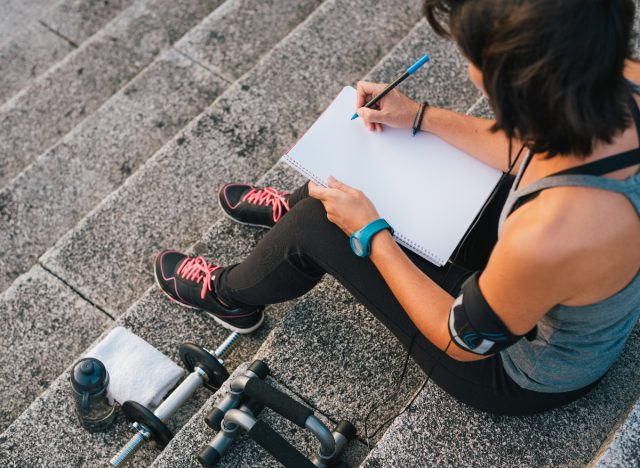A Trainer’s Top-Recommended Diet & Exercise Plan To Lose Your Large Belly

Let’s be honest: Weight loss can be a real pain in the you-know-what—especially when it comes to shrinking your belly size. And with so much online noise arguing over which diet is optimal (keto, low-fat, high-carb, low-carb, vegan, carnivore *exasperated sigh*) and which type of workouts are best for melting belly fat, it’s understandable why many people throw their hands up in defeat and continue with their same old eating and exercise habits. Fortunately, we here at ETNT empathize with your weight loss woes and have the ultimate regimen that’ll help you lose your large belly.
To help you filter through the online confusion, we asked Kate Meier, CPT, a certified personal trainer with Garage Gym Reviews, to give us the rundown of her top-recommended diet and exercise plan to help you say goodbye to belly fat for good. Regardless of your current diet or fitness level, following this protocol is a surefire way to torch calories and help get you on track to a tighter tummy (and even help you develop those highly sought-after six-pack abs).
If you want to see your belly fat vanish into thin air, read on for Meier’s top-notch diet and exercise tips to improve your health and take your fitness to the next level. And when you’re finished, check out how to Melt Lower Belly Fat With These Bodyweight Exercises.
Dial in your diet.

While there’s no one-size-fits-all approach to nutrition, everyone can follow certain diet principles. Most notable is calorie intake, which will determine whether you gain or lose weight depending on your fitness goals. For example, you may need to eat a caloric surplus of 500 calories per day if your goal is to build muscle and gain weight. Conversely, a caloric deficit of 500 calories daily can help you lose weight. The key is to eat plenty of whole foods that provide a healthy macronutrient balance (carbs, fats, proteins) while meeting your caloric requirements and adhering to a regular exercise routine.
“The easiest way to calculate the number of calories you need to reach your goals is through an online calculator,” says Meier. “This will do the math and give you an idea of what to aim for calorie-wise in combination with your workout plan.”
Meier adds, “Getting at least 0.8 grams of protein per kilogram of body weight is recommended to avoid any deficiencies for an average person. But if you train frequently, you may need more. Protein should make up anywhere between 10% to 35% of the average diet, but active individuals will want to skew toward the higher end of that range.”
Be realistic.

If your fitness goal is to lose your large belly, the key to success is being realistic with your capabilities. For instance, if you’ve never done a bench press before, you wouldn’t walk into the gym and expect to lift 300 pounds. Know your limitations, and gradually progress your fitness over time.
“As you set your overall goals, ensure they’re specific and achievable within the time frame you set. Whether you aim to lose, gain, or maintain, setting goals that are too lofty from the start will typically lead to discouragement,” advises Meier.
Allow for flexibility.

While having a workout plan and schedule is essential for creating consistency, being too rigid with them will set you up for failure. Don’t be afraid to occasionally enjoy a meal out with friends or take a day off from training if you’re feeling burnt out.
“If you stay consistent overall, allowing for flexibility at times is healthy and can help prevent you from falling into an ‘all or nothing’ mindset with your fitness plan, which can lead to anxiety and makes most people more likely to quit after a slip-up,” says Meier.
Set priorities.

In the Internet era of a-million-and-one-things competing for your attention at any given moment, finding time for what’s important to you is easier said than done. However, if something matters to you, you’ll make the time to do it. For example, if you genuinely want to improve your health and fitness and lose weight, you’ll make the time to meal prep on the weekend when you know you’ll be busy with work during the week, or get up extra early to squeeze in a run or workout session before the day starts.
“Make sure that fitness is a priority in your day-to-day schedule, and allot time for it the same way you would a work meeting or social event,” Meier recommends. “This will ensure you create the space for it and make you more likely to reach your goals.”
Set small goals along the way.

Sure, big-picture goals can be a compass on your health and fitness journey. But setting too big of goals may discourage you along the way. That’s why it’s critical to create small, attainable goals that push you in the direction you want while keeping you motivated.
“When setting long-term goals, brainstorm other short-term goals that feed into your overall objective. This way, you’ll have more opportunities to succeed and feel good about where you’re at,” says Meier. “Plus, these smaller goals can help you stay accountable for your entire fitness journey and give you opportunities to get back on track if things aren’t going to plan.”
Try this workout plan.

To help you get started, try Meier’s weekly workout plan that will incinerate calories and lose your large belly.
“Before each workout, warm up with light cardio to get your blood flowing and your muscles primed. Then, after each workout, cool down with a walk and some stretching to kickstart your recovery. You can repeat this plan for as many weeks as you like, either slowly increasing the weight you work with or modifying the number of sets and reps to push yourself further,” explains Meier.
Day 1: Upper Body
- Pushups | 3 to 4 sets of 10 reps
- Overhead press | 3 sets of 8 reps
- Chest press | 3 sets of 8 to 10 reps
- Dumbbell flyes | 3 sets of 10 to 12 reps
- Dumbbell pullover | 3 sets of 10 to 12 reps
Day 2: Lower Body
- Barbell or dumbbell squat | 3 sets of 10 to 12 reps
- Three-way lunge | 3 sets of 8 reps per side
- Straight-leg deadlift | 3 sets of 10 to 12 reps
- Donkey kicks | 3 sets of 12 reps per side
- Clamshells | 3 sets of 10 reps per side
Day 3: Rest Day
Day 4: Upper Body
- Pushups | 3 to 4 sets of 10 reps
- Arnold press | 3 sets of 8 reps
- Biceps curls | 3 sets of 10 to 12 reps
- Lateral raise | 3 sets of 10 to 12 reps
- Front raise | 3 sets of 10 to 12 reps
Day 5: Lower Body
- Deadlift or sumo deadlift | 3 sets of 8 to 10 reps
- Split squat | 3 sets of 8 reps per leg
- Jump squat | 3 to 4 sets of 10 reps
- Speed skaters | 3 to 4 sets of 10 reps
- Plank | 3 reps, aiming to hold for at least 45 seconds
Day 6: Rest Day








